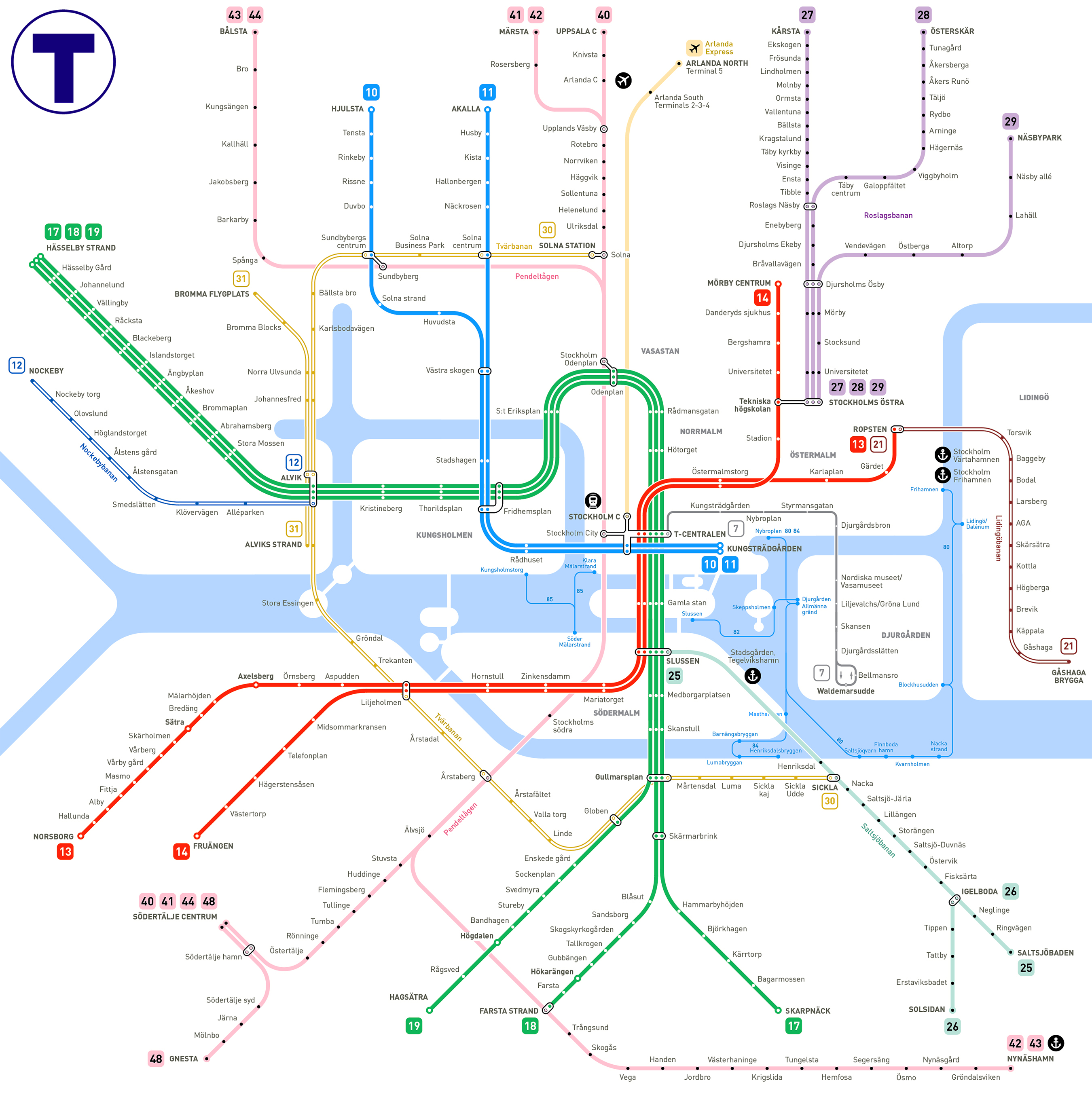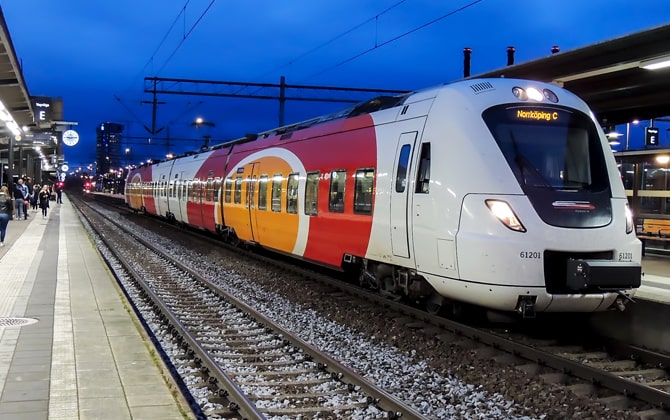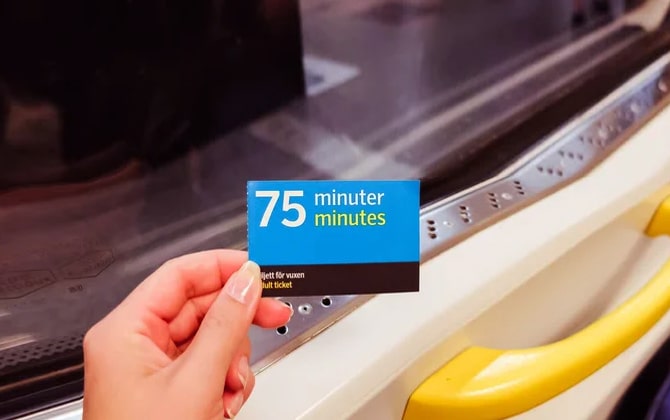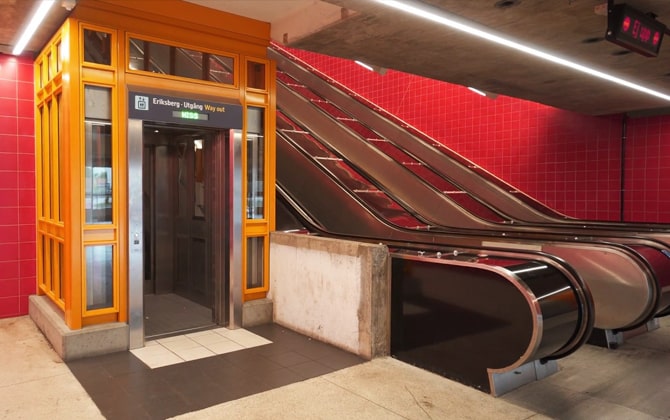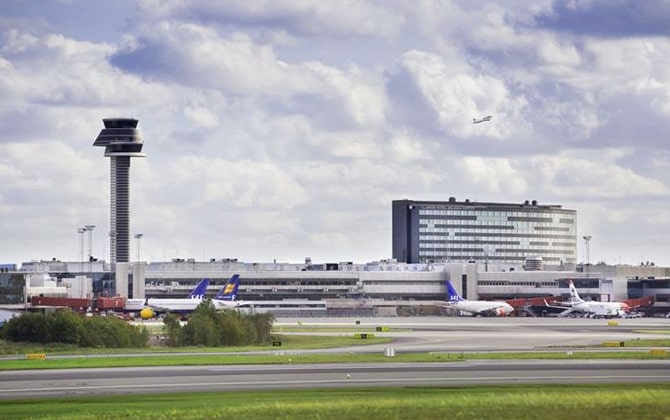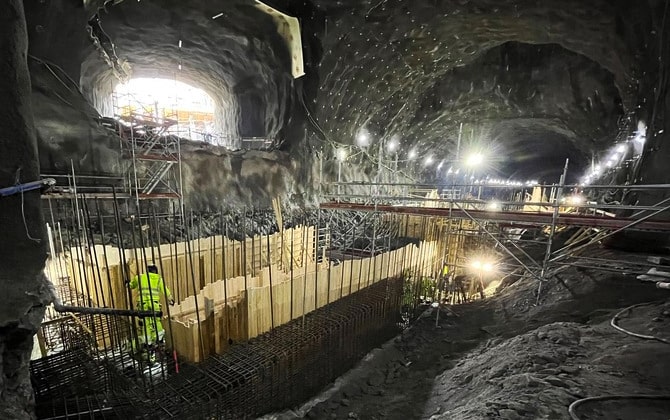The Stockholm Metro (Tunnelbana) is Sweden’s only metro system. It opened in 1950. Today it has three color-coded lines—Green, Red and Blue—serving 100 stations over about 105.7 km (≈65.7 mi) of track. All lines converge in the city centre at T-Centralen, which links to commuter trains. Major interchanges include Fridhemsplan, Slussen and Gamla Stan. Region Stockholm owns the network, and SL manages operations. Stations have low-floor platforms for step-free access; most feature elevators or escalators, digital displays and ticket barriers that accept SL app tickets, rechargeable SL cards or contactless payments. The metro is famous for its art, with more than 90 stations decorated by artists—earning it the title “the world’s longest art gallery.” Service runs frequently and integrates with SL’s buses, trams and commuter trains.
Stockholm Metro Map (2026)
The official 2026 Stockholm Metro map shows three color-coded lines—Green, Red and Blue—each split into numbered routes. The Blue line runs routes T10 and T11; the Red runs T13 and T14; the Green runs T17, T18 and T19. The map covers stations from Kungsträdgården in the east to Norsborg and Fruängen in the south-west, and from Älvsjö in the south to Mörby centrum in the north. Planned extensions to Barkarby, Nacka and Arenastaden appear on SL’s interactive planner. All stations lie within Zone A, so a single-zone ticket covers the entire network.
Click on the Stockholm Tunnelbana map to enlarge it or download the Stockholm subway map in PDF format.
Stockholm Metro Lines and Routes
The Stockholm Metro has three main lines—Green (Lines 17/18/19), Red (Lines 13/14) and Blue (Lines 10/11)—forming seven service routes. All routes pass through downtown Stockholm. In total, 100 stations span three lines: 47 underground and 53 above ground.
Blue Route: Stations and Highlights
The Blue line runs from Kungsträdgården through T-Centralen to Västra Skogen, where it splits into two branches:
- Line 10 heads north-west to Hjulsta.
- Line 11 continues via Rinkeby and Akalla.
Key stations:
- Kungsträdgården – eastern terminus near the Old Town’s shops and historic sites.
- T-Centralen – central hub with connections to Red and Green lines and commuter rail.
- Rådhuset – features blue-violet art installations.
- Fridhemsplan – interchange with the Green line toward Alvik.
- Västra Skogen – junction where the line splits.
- Hallonbergen and Rissne – serve the Solna suburbs.
- Hjulsta – terminus on Line 10.
- Akalla – terminus on Line 11.
The Blue line runs entirely underground from Kungsträdgården to Västra Skogen, ensuring quick city-centre access. Stations feature striking artwork and deep platforms. Onboard screens and platform displays show real-time departures and destinations. Extensions will reach Barkarby by 2027 and expand south toward Nacka and Söderort by around 2030.
Red Route: Stations and Highlights
The Red line has two main routes:
- Line 13 – Norsborg to Ropsten.
- Line 14 – Fruängen to Mörby centrum.
Key stations:
- Norsborg – southwestern terminus in Botkyrka.
- Fittja, Hallunda, Alby – residential stops on the Norsborg branch.
- Vårby Gård, Vårberg, Skärholmen, Sätra – served by both branches toward the city.
- Liljeholmen – southern hub with shops and a tram interchange.
- T-Centralen – central interchange (separate platforms from the Green line).
- Gamla Stan – deep-level station in the Old Town with Slussen access.
- Tekniska högskolan, Stadion, Östermalmstorg – central east stops near universities and shopping.
- Universitetet – gateway to Norra Djurgården parklands.
- Mörby centrum – northern terminus in an affluent suburb with a shopping mall.
- Ropsten – northeastern terminus near the Lidingö ferry.
Trains run every 5–10 minutes on each branch. The Red line offers convenient tourist access to Gamla Stan and Slussen. Transfers at Fridhemsplan and T-Centralen link you to any part of the city.
Stockholm Commuter Train Integration
Stockholm’s metro connects seamlessly with the SL commuter rail (Pendeltåg) and other transit modes. Pendeltåg serves about 53 stations, linking suburbs and nearby cities like Märsta, Uppsala, Nynäshamn and Södertälje. The same SL ticket or card works on metro, Pendeltåg, buses, trams and ferries. Major transfer hubs are Stockholm City (under T-Centralen) and Odenplan (under Odenplan metro). At these stations, you can make cross-platform or same-level transfers. For example, ride from Uppsala to Stockholm City by Pendeltåg, then walk to T-Centralen for the metro. SL’s Access card and contactless payments cover every mode. SL’s journey planner shows combined routes across metro, Pendeltåg and buses.
Stockholm Metro Fares and Ticket Prices
Stockholm uses a unified zonal fare system. Zone A covers all city metro travel. You pay with an SL Access card, the SL app or contactless bank cards. Adult fares (2026) are:
- Single journey (75 min, any transfers): 43 SEK (~$5)
- 24-hour ticket: 180 SEK (~$18)
- 72-hour ticket: 360 SEK (~$36)
- 7-day ticket: 470 SEK (~$47)
- 30-day ticket: 1 060 SEK (~$105)
- 90-day ticket: 3 070 SEK (~$300)
- 365-day pass: 11 130 SEK (~$1 100)
Youth (7–19), students and seniors (65+) pay about half price. Children under 7 ride free; those 7–11 ride free with an adult. Single tickets activate immediately and last 75 minutes. Tap your card at the platform gates. The ticket covers all travel in Zone A. Buy tickets in the SL app, at machines or service centres. An SL Access card costs 20 SEK (~$2).
Individual Tickets
Single-trip tickets are ideal for occasional rides. Load them onto your SL Access card or the app before boarding. An adult single trip costs 43 SEK (~$5). Reduced tickets (20–25 SEK, ~$2–3) are available for youths, students and seniors. Tap your card at the gates; no extra validation is needed. Re-enter within 75 minutes using the remaining time.
SL Access Card & Metro Passes
Frequent travellers should use an SL Access card. It’s a reloadable smartcard that costs 20 SEK (~$2) once. Load any period pass—24 h, 30 d, 90 d or yearly—onto the card or the app. A 30-day pass costs 1 060 SEK (~$105). Pass holders get unlimited rides on all SL transit during validity. Buy or top up passes at SL service centres, the app or station machines. Most stations have renewal machines next to escalators. Short-duration tickets can be paper (SMS) tickets, but longer passes require the Access card or app.
Stockholm Metro Timetable & Operating Hours
On weekdays and Saturdays, trains run from about 05:00 until 01:00. Peak hours (06:30–09:00 and 16:00–18:30) see service every 4–6 minutes per route (2.5–5 minutes in central sections). Midday intervals are 5–6 minutes; evenings until 21:00 are about 10 minutes. From 21:00 to end of service, trains come every 15 minutes, dropping to every 30 minutes after midnight. On Friday and Saturday nights, the metro runs all night with roughly 30-minute intervals. Outside those nights, service stops after the last train until around 05:00; night buses and trams cover those hours.
- Weekday/Saturday day (peak): ~5 min intervals in core sections.
- Evening (21:00–00:00): ~10–15 min intervals.
- Late night (after 00:00): ~30 min intervals.
- Friday/Saturday night: ~30 min intervals all night.
Exact first and last train times vary by line and station. SL publishes detailed schedules online via its journey planner and posted charts.
Infrastructure and Facilities
Stations are clean and well maintained. Trains have high floors and wide doors; platforms feature tactile strips and LED lighting. Major interchanges (T-Centralen, Fridhemsplan, Slussen) span multiple levels with escalators and elevators. Most stations display electronic boards showing upcoming trains and destinations.
- Escalators (often in banks) and elevators at deep stations.
- Tactile guidance paths for visually impaired passengers.
- Snow-melting underpasses on outdoor platforms.
- Public toilets at larger stations.
- Convenience kiosks or small shops near entrances.
- SL Access top-up machines on platforms.
- Ticket gates with information screens and help points.
The metro is largely wheelchair-friendly; request a “ramp to the train” at customer service. Some stations (e.g., Alvik) offer direct transfers to light rail or commuter trains. Artwork is a highlight—T-Centralen’s “Blue Hall” tunnel resembles an underwater cave.
Safety and Regulations
The Tunnelbana is safe and orderly. SL enforces rules for security and comfort. Smoking and vaping are banned on trains and platforms. Drinking alcohol or carrying open containers is forbidden. Loud music and disruptive behaviour are not allowed. Inspectors and uniformed staff make random ticket checks. Since 2024, e-scooters and other battery-powered devices are banned for fire safety. Folding bikes are allowed off-peak; full-size bikes must stay out. On escalators, stand on the right and let others pass on the left. Do not cross tracks or enter restricted areas. In emergencies, use marked exits and intercoms to alert staff. Platforms have warning lines and door-closing announcements. Surveillance cameras monitor stations. SL prohibits flammable or dangerous cargo. No major safety incidents have been recorded in 2026. Modern signalling and crowd management keep service reliable.
Connection to the Airport
Stockholm Arlanda Airport (ARN) lies north of the city. The Arlanda Express takes 20 minutes to reach central Stockholm. It costs 350 SEK (~$35). SL’s Pendeltåg commuter rail also serves Arlanda via Stockholm City Station. You need a standard SL ticket plus a 147 SEK (~$15) Arlanda supplement. A one-way trip costs about 190 SEK (~$19). Many travellers use Flygbussarna airport coaches. They take 60–70 minutes to the city and cost around 120 SEK (~$12). Stockholm Bromma Airport (BMA) is west of the centre. There is no direct metro service. From Brommaplan station (Green line), take bus 152 or tram 13/14 via Alvik. The bus ride to the terminals takes about 10 minutes and uses a Zone A ticket.
Future Developments & Expansion
Construction is under way to extend the Blue line northwest from Akalla to Barkarby, with new stations at Barkarbystaden and Barkarby set to open in December 2027. From Kungsträdgården, a southern branch will tunnel under Södermalm and split around 2030 into two lines: one reaching Nacka Centrum via Sofia, Hammarbykanal, Sickla and Järla, the other rerouting the Hagsätra branch through Årstaberg. This new corridor will ease crowding at T-Centralen and Slussen by providing an alternate north–south link.
Around 2028, a branch of the Green line will run north from Odenplan through Hagastaden and Södra Hagalund to Solna’s Arenastaden, connecting growing hospital and office districts with an 11-minute ride to T-Centralen. A completely new Yellow line (T20/T21) will start construction in 2026, stretching south from Fridhemsplan to Älvsjö over a nine-year build period. This line will create a direct central–southern route and relieve pressure on the Green and Red lines.
SL is also expanding the Högdalen depot to support the extra trains these projects will bring. Collectively known as “Nya tunnelbanan,” the extensions will add more than 30 km (≈18.6 mi) of new tunnels and dozens of stations by the 2030s. SL maps and apps already show these future stations in planning mode.
History and Heritage
Planning for the Stockholm Metro dates back to the 1930s, when engineers began digging tunnels under Södermalm. The first underground section opened in 1950 between Slussen and T-Centralen, using a former tram tunnel—making Tunnelbana the first metro in the Nordic countries. By 1957 the line had reached Östermalmstorg, and through the 1960s and 1970s the network expanded into the three-color system we know today.
Art and architecture are central to the metro’s character. More than 90 stations display murals, mosaics, sculptures and installations created by over 150 artists. Highlights include the exposed red-bedrock caverns at Kungsträdgården and the vivid blue-and-red “cave” ceiling in Solna Centrum. These works have earned the network the nickname “the world’s longest art gallery.”
In the 21st century, SL modernized the system with new C30 and C40 trains, upgraded signalling and digital information screens. Since 2009, MTR has operated the network under contract, and by 2022 the shift from paper tickets to SL Access smartcards and an app-based system was complete. Before the pandemic, Tunnelbana carried nearly 500 million passengers a year and remains Stockholm’s transit backbone.
